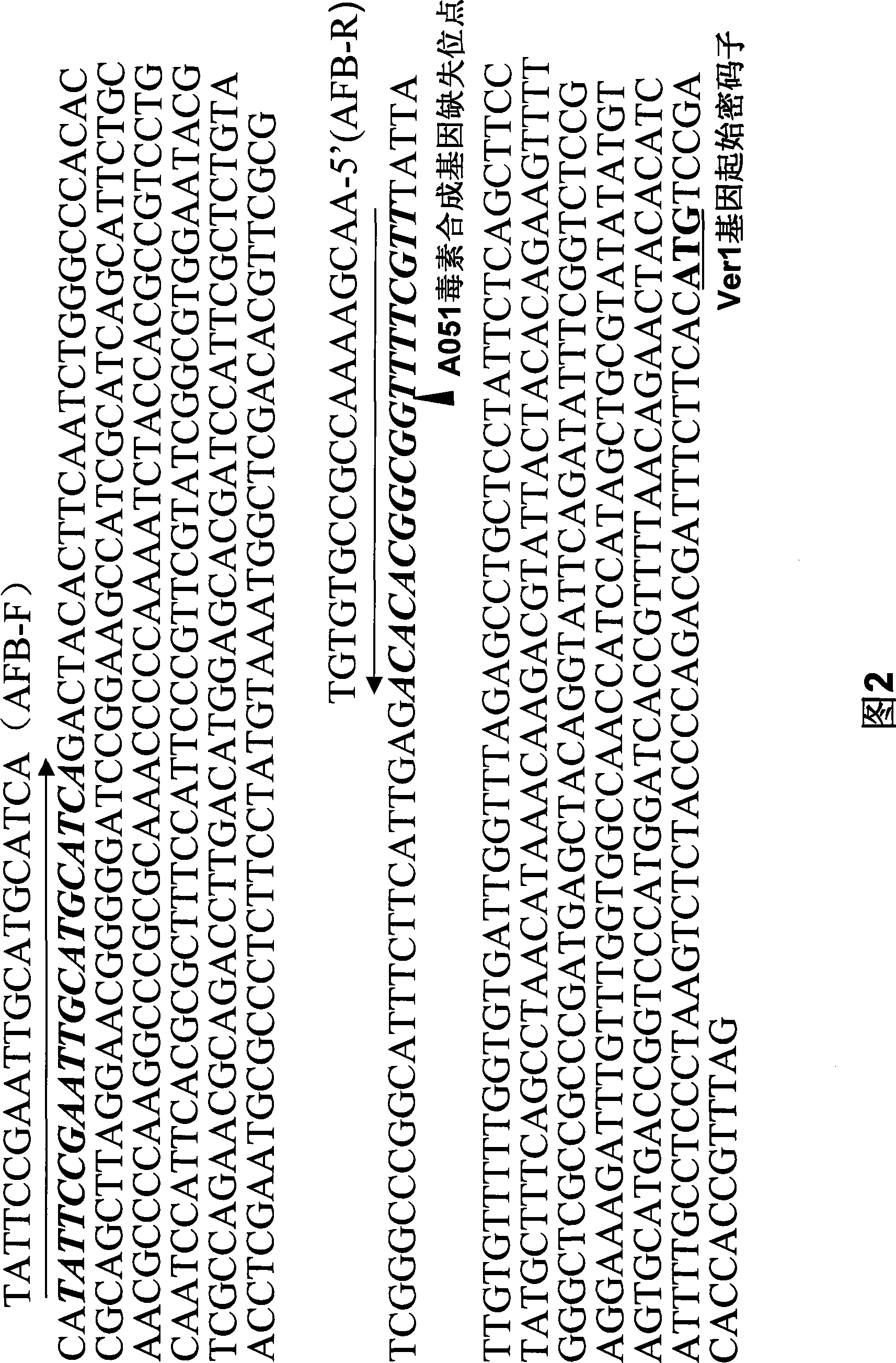Aspergillus flavus strain without producing aspergillus flavus toxin and uses thereof
A technology for aflatoxins and strains of Aspergillus flavus, which can be used in applications, fungicides, fungi, etc., can solve the problem of not having a good inhibitory effect, and achieve the effect of reducing the risk of aflatoxin contamination and high competitiveness.
- Summary
- Abstract
- Description
- Claims
- Application Information
AI Technical Summary
Problems solved by technology
Method used
Image
Examples
Embodiment 1
[0026] Embodiment 1, collection, separation, identification of biocontrol bacterial strain A051 (being Aspergillus flavus strain A051)
[0027] (1), isolate Aspergillus flavus strain from soil
[0028] Aspergillus flavus strains were isolated from the soil collected from peanut fields in Jiangsu, Zhejiang, Shandong, etc. with YES medium. Per liter of YES medium composition: Yeast extract 1g, sucrose 10g, NaCl 60g, agar 20g, add CuSO4.ZnSO41ml, 0.4% nitramine 5ml, streptomycin 100ppm after sterilization.
[0029] (2), use bioassay, thin-layer chromatography and molecular biological method to screen out the aspergillus flavus strain that does not produce AFT wherein, measure the growth rate of these not producing AFT bacterial strains, sporulation amount, the survival period in soil then and Competitiveness with AFT-producing strains and other indicators, thus screening a highly competitive non-AFT-producing Aspergillus flavus strain A051. details as follows:
[0030]Bioassay...
Embodiment 2
[0034] Example 2, Deletion Determination of Strain A051 Toxin Synthesis Gene
[0035] (1) Primer synthesis
[0036] The present invention is based on the sequence of the toxin synthesis gene of Aspergillus flavus with Genbank accession number AY510451, and designs the detection of toxin synthesis related genes C1, C3, norB, cypA, aflT, pksA, aflR, norA, ver1, verA, ordA, hypA And glcA primers, primer sequences and amplified fragment size are shown in Table 1.
[0037] Table 1. Primer sequences of different toxin synthesis genes
[0038] Gene
Primer name
Sequence (5'-3')
The amplified fragment is large
small C1
C1-F
C1-R CCGTTGCAGTTAAAACTCACA (SEQ ID NO: 1)
GAAGCTCGATCTTCTCCATGA (SEQ ID NO: 2) 409
C3
C3-F
C3-R TCTGGAGTCGGAGGTTAGGTT (SEQ ID NO: 3)
GAGCAACACGATCATTGCAT (SEQ ID NO: 4) 544
norB
cypA norB-cypA-F
norb-cypA-R GTGCCCAGCATCTTGGTCCA (SEQ ID NO: 5)
AGGACTTGATGATTCCTCGTC (SEQ ID NO: 6) ...
Embodiment 3
[0044] Example 3, Determination of the Deletion Site Sequence of the Toxin Synthesis Gene of Bacterial Strain A051
[0045] It has been determined by the above method that the strain A051 is deleted from the first toxin synthesis gene to the toxin synthesis gene norA, and is complete from the ver1 gene to the last toxin synthesis gene. According to the sequence of ver1, three specific nested primers AFT1, AFT2 and AFT3 were designed and combined with one random primer RA5 for Tail-PCR amplification to determine the specific deletion site. (See Table 2 for primer sequences)
[0046] Table 2. Sequences of nested primers and random primers used in Tail-PCR amplification
[0047] Primer name Primer sequence (5'-3') AFT1 CATCGGCCTGGATTGCGATA (SEQ ID NO: 27) AFT2 ACTTTCTCCGCGGCCTCAC (SEQ ID NO: 28) AFT3 CGCCGGTGACTAAGGCCACT (SEQ ID NO: 29) RA5 WGTGNAGWANCANAGA
[0048] Carry out nested PCR reactions according to the following steps, each...
PUM
 Login to View More
Login to View More Abstract
Description
Claims
Application Information
 Login to View More
Login to View More - R&D
- Intellectual Property
- Life Sciences
- Materials
- Tech Scout
- Unparalleled Data Quality
- Higher Quality Content
- 60% Fewer Hallucinations
Browse by: Latest US Patents, China's latest patents, Technical Efficacy Thesaurus, Application Domain, Technology Topic, Popular Technical Reports.
© 2025 PatSnap. All rights reserved.Legal|Privacy policy|Modern Slavery Act Transparency Statement|Sitemap|About US| Contact US: help@patsnap.com



